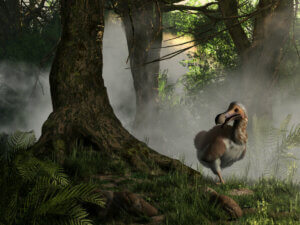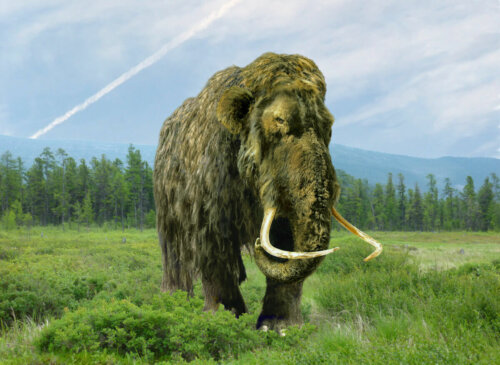Is It Possible to Recover Extinct Species?

Humans try to recover extinct species because we consider it a cruel fate. However, it’s been the norm since the beginning of time, throughout the history of our planet. In fact, the decline in species diversity at the global level was due to the various mass extinctions, caused by other smaller phenomena at a local level.
Thus, extinct species constantly give way to others that are better prepared to use the resources of an ecosystem that’s constantly balancing. Unfortunately, human intervention on pretty much every element of the planet, directly or indirectly, continues to lead to the extinction of numerous species. Unfortunately, it’s happening at a dizzying rate.
This raises an interesting question: should we try to bring back such species? Continue reading to learn more about this subject and the ethical considerations that come with it.
What’s the point of bringing back extinct species?
It’s interesting to know that a scientific sector has promoted a new intervention of the world which they have called de-extinction in recent decades. This initiative proposes the creation – through the use of genetic methodologies – of an organism that is, or resembles, a member of an extinct species.
Is it possible?
Certainly, the technology necessary to bring back an extinct species is currently at our disposal. In fact, there are three ways to do so:
- Cloning
- Genetic engineering
- Selective reproduction or strategic mating
Cloning involves inserting a nucleus of cells from the extinct animal into the unfertilized egg of a host species. Then, the scientist implants the cell into a surrogate. You may not know it but they used this method for cloning Dolly the sheep in 1996. They also cloned a Pyrenean mountain goat in 2009, although, it had a very short life – only 10 minutes.
Thus, theoretically, one could replace the nucleus of a female elephant egg with another one extracted from a woolly mammoth’s cell. Simply explained, it replaces the elephant’s genetic code with that of the mammoth.
An electrical pulse causes the cell to start multiplying, and an embryo will develop if it all goes well. The embryo is then placed in a female elephant to continue the usual gestation process.

The other two methods
Scientists rescue fragments of DNA sequences from an extinct animal and fill in the gaps – missing sequences – with DNA information from a closely related living species when doing the genetically engineered approach. This alternative enhances by the advent of the CRISPR system for targeted DNA insertion.
Alternatively, scientists identify certain traits and selectively breed close living relatives of an extinct species until the living specimens begin to resemble their extinct ancestors in selective breeding or strategic mating.
Researchers use a combination of these methods to try to bring back extinct species.
Are there projects underway to recover extinct species?
As we said above, there are many de-extinction projects currently underway such as the efforts to revive the passenger pigeon, the woolly mammoth, and the gastric-breeding frog. Currently, there are efforts invested in other emblematic animal species apart from the aforementioned. Among them, the moa, the Carolina parakeet, and the Yangtze River dolphin.
There’s also a project to revive the quagga (Equus quagga quagga), a subspecies of the common zebra in South Africa. This project aims to reproduce a population morphologically close to the original one. They launched this initiative in 1987 and by 2005 the fifth generation animals had recognizable quagga characteristics.
Is it a good idea to bring back extinct species?
There are divided opinions on this subject — as in all controversial issues. People for it argue we have a moral obligation to recover those animals that have disappeared due to human intervention.
For example, the passenger pigeon, Steller’s sea cow, and dodo disappeared due to hunting, habitat destruction, and anthropogenic diseases. Some theorize that all these animals would still be around if it wasn’t for humans.
Furthermore, experts point out that this may be a way to increase biodiversity. For example, large grazing herbivores such as woolly mammoths could improve soil quality or convert barren areas of Siberian tundra into rich pastureland.
Reasons not to bring back extinct species
Opponents of de-extinction argue that these techniques could take resources away from current species conservation efforts programs. This would put even more animals at risk of extinction.
In addition, reintroduced species may not be able to survive in the wild. This is because their old habitats no longer exist. Thus, these animals would lack defense mechanisms to protect themselves from current predators.
In addition, their immune systems may not be equipped to deal with new pathogens. Once infected with certain parasites, these revived animals could transmit diseases to other species, which would have a negative impact on current ecosystems.

In short, it isn’t clear who’ll win the debate, especially since we don’t know exactly where the research on extinction will lead. Clearly, we’ll have to make difficult decisions in the future. What do you think?
All cited sources were thoroughly reviewed by our team to ensure their quality, reliability, currency, and validity. The bibliography of this article was considered reliable and of academic or scientific accuracy.
- Shapiro, B. (2015). How to clone a mammoth: the science of de-extinction. Princeton University Press. http://assets.press.princeton.edu/catalogs/S15Trade.pdf
- Cohen, S. (2014). The ethics of de-extinction. NanoEthics, 8(2), 165-178.
- Babcock, H. M. (2019). The Genie is Out of the De-Extinction Bottle: A Problem in Risk Regulation and Regulatory Gaps. Va. Envtl. LJ, 37, 170. http://www.velj.org/uploads/1/2/7/0/12706894/37.3.1_babcock.pdf
This text is provided for informational purposes only and does not replace consultation with a professional. If in doubt, consult your specialist.